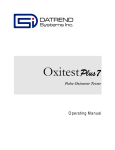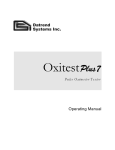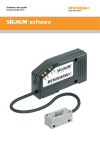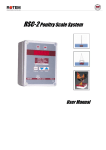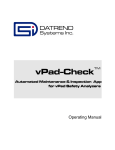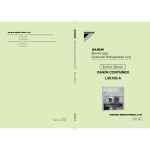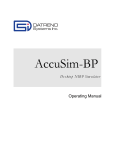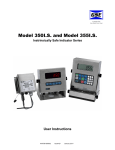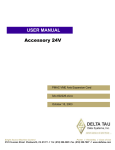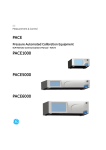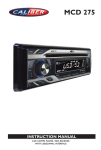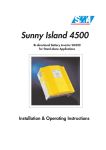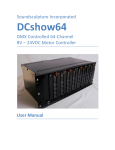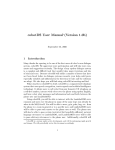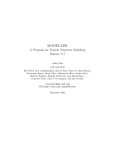Download Phase-3 vPad XSC for User Manual
Transcript
vPad-XSC ™ Automation Interface for Phase 3 Defibrillator Analyzer User Manual vPad-XSC™ Automation Interface for Phase 3 Defibrillator Analyzer User Manual © 2014 Datrend Systems Inc. 130 - 4020 Viking Way Richmond, BC • CANADA • V6V 2L4 Tel: 800.667.6557 (North America Only) or 604.291.7747 • Fax 604.294.2355 e-mail: [email protected] To order this manual, use Part Number 6100-089 Revision A Revision History Description Initial Release Date 2014-Nov-26 Copyright Datrend Systems Inc. (“DSI”) agrees to a limited copyright release that allows you to reproduce manuals and other printed materials for use in service training programs and other technical publications. If you would like other reproductions or distributions, submit a written request to Datrend Systems Inc. Unpacking and Inspection Follow standard receiving practices upon receipt of the instrument. Check the shipping carton for damage. If damage is found, stop unpacking the instrument. Notify the freight carrier and ask for an agent to be present while the instrument is unpacked. There are no special unpacking instructions, but be careful not to damage the instrument when unpacking it. Inspect the instrument for physical damage such as bent or broken parts, dents, or scratches. Claims Our routine method of shipment is via common carrier. Upon delivery, if physical damage is found, retain all packing materials in their original condition and contact the carrier immediately to file a claim. If the instrument is delivered in good physical condition but does not operate within specifications, or if there are any other problems not caused by shipping damage, please contact your local sales representative or DSI immediately. Standard Terms and Conditions Refunds & Credits Please note only serialized products (products labelled with a distinct serial number) and accessories are eligible for partial refund and/or credit. Non-serialized parts and accessory items (cables, carrying cases, auxiliary modules, etc.) are not eligible for return or refund. In order to receive a partial refund/credit, the product must not have been damaged, and must be returned complete (meaning all manuals, cables, accessories, etc.) within 90 days of original purchase and in “as new” and resalable condition. The Return Procedure must be followed. Return Procedure Every product returned for refund/credit must be accompanied by a Return Material Authorization (RMA) number, obtained from Datrend Customer Service. All items being returned must be sent prepaid (freight, duty, brokerage, and taxes ) to our factory location. Restocking Charges Products returned within 30 days of original purchase are subject to a minimum restocking fee of 15%. Products returned in excess of 30 days after purchase, but prior to 90 days, are subject to a minimum restocking fee of 20%. Additional charges for damage and/or missing parts and accessories will be applied to all returns. Products which are not in “as new” and resalable condition, are not eligible for credit return and will be returned to the customer at their expense. Certification This instrument was thoroughly tested and inspected and found to meet DSI’s manufacturing specifications when it was shipped from the factory. Calibration measurements are traceable to the National Research Council of Canada (NRC) and/or the National Institute of Standards and Technology (NIST). Devices for which there are no NRC/NIST calibration standards are measured against in-house performance standards using accepted test procedures. Page i Warranty Warranty and Product Support Datrend Systems Inc. ("DSI") warrants this instrument to be free from defects in materials and workmanship under normal use and service for 90 days from the date of original purchase. During the warranty period DSI will, at our option, either repair or replace defects in materials and workmanship at no charge; provided the product is returned (shipping, duty, brokerage and taxes prepaid) to DSI. Any and all transportation charges incurred are the responsibility of the purchaser and are not included within this warranty. This warranty extends only to the original purchaser and does not cover damage from abuse, neglect, accident or misuse or as the result of service or modification by other than DSI. IN NO EVENT SHALL DATREND SYSTEMS INC. BE LIABLE FOR CONSEQUENTIAL DAMAGES. No warranty shall apply when damage is caused by any of the following: ! Power failure, surges, or spikes, ! Damage in transit or when moving the instrument, ! Improper power supply such as low voltage, incorrect voltage, defective wiring or inadequate fuses, ! Accident, alteration, abuse or misuse of the instrument, ! Fire, water damage, theft, war, riot, hostility, acts of God, such as hurricanes, floods, etc. Only serialized products (those items bearing a distinct DSI serial number tag) are covered under this warranty. PHYSICAL DAMAGE CAUSED BY MISUSE OR PHYSICAL ABUSE IS NOT COVERED UNDER THE WARRANTY. Items such as cables and non-serialized modules are not covered under this warranty. This warranty gives you specific legal rights and you may have other rights, which vary from province to province, state to state, or country to country. This warranty is limited to repairing the instrument to DSI's specifications. When you return an instrument to DSI for service, repair or calibration, we recommend shipment using the original shipping foam and container. If the original packing materials are not available, we recommend the following guide for repackaging: ! Use a double-walled carton of sufficient strength for the weight being shipped. ! Use heavy paper or cardboard to protect all instrument surfaces. Use non-abrasive material around all projecting parts. ! Use at least four inches of tightly packed, industrial-approved, shock-absorbent material all around the instrument. DSI will not be responsible for lost shipments or instruments received in damaged condition due to improper packaging or handling. All warranty claim shipments must be made on a prepaid basis (freight, duty, brokerage, and taxes). No returns will be accepted without a Return Materials Authorization ("RMA”) number. Please contact Datrend (refer to Chapter 4 of this manual) to obtain an RMA number and receive help with shipping/customs documentation. Page ii Warranty Disclaimer Should you elect to have your instrument serviced and/or calibrated by someone other than Datrend Systems, please be advised that the original warranty covering your product becomes void when the tamper-resistant Quality Seal is removed or broken without proper factory authorization. We strongly recommend, therefore, that you send your instrument to Datrend Systems for service and calibration, especially during the original warranty period. In all cases, breaking the tamper-resistant Quality Seal should be avoided at all cost, as this seal is the key to your original instrument warranty. In the event that the seal must be broken to gain internal access to the instrument (e.g., in the case of a customer-installed firmware upgrade), you must first contact Datrend Systems at 1-800-667-6557. You will be required to provide us with the serial number for your instrument as well as a valid reason for breaking the Quality Seal. You should break this seal only after you have received factory authorization. Do not break the Quality Seal before you have contacted us! Following these steps will help ensure that you will retain the original warranty on your instrument without interruption. WARNING Unauthorized user modifications or application beyond the published specifications may result in electrical shock hazards or improper operation. Datrend Systems will not be responsible for any injuries sustained due to unauthorized equipment modifications. DSI DISCLAIMS ALL OTHER WARRANTIES, EXPRESSED OR IMPLIED, INCLUDING ANY WARRANTY OF MERCHANTABILITY OR FITNESS FOR A PARTICULAR PURPOSE OR APPLICATION. THIS PRODUCT CONTAINS NO USER-SERVICEABLE COMPONENTS. UNAUTHORIZED REMOVAL OF THE INSTRUMENT COVER SHALL VOID THIS AND ALL OTHER EXPRESSED OR IMPLIED WARRANTIES. vPad™, vPad-XSC™, vPad-Check™ and Phase 3 are trademarks of Datrend Systems Inc. Android™ is trademark of Google Inc. Page iii Page iv vPad-XSC for Phase 3 USER MANUAL Table of Contents TABLE OF CONTENTS . . . . . . . . . . . . . . . . . . . . . . . . . . . . . . . . . . . . . . . . . . . . . . V 1 OVERVIEW . . . . . . . . . . . . . . . . . . . . . . . . . . . . . . . . . . . . . . . . . . . . . . . . . . . . 1 1.1 Standard Accessories . . . . . . . . . . . . . . . . . . . . . . . . . . . . . . . . . . . . . . . . . . . . 1 1.2 Optional Accessories . . . . . . . . . . . . . . . . . . . . . . . . . . . . . . . . . . . . . . . . . . . . . 1 1.3 Checklists and vPL . . . . . . . . . . . . . . . . . . . . . . . . . . . . . . . . . . . . . . . . . . . . . . 2 2 CONNECTION AND SETUP . . . . . . . . . . . . . . . . . . . . . . . . . . . . . . . . . . . . . . . . . 3 3 CHECKLIST PROGRAMMING . . . . . . . . . . . . . . . . . . . . . . . . . . . . . . . . . . . . . . . . 5 3.1 Initialization . . . . . . . . . . . . . . . . . . . . . . . . . . . . . . . . . . . . . . . . . . . . . . . . . . . . 5 3.2 Configuration . . . . . . . . . . . . . . . . . . . . . . . . . . . . . . . . . . . . . . . . . . . . . . . . . . 6 3.2.1 Setting Limits and Tolerances . . . . . . . . . . . . . . . . . . . . . . . . . . . . . . . . . . 6 3.2.1.1 Example 1: Setting a Defibrillator Energy Limit . . . . . . . . . . . . . . . . . 8 3.2.1.2 Example 2: Setting Defibrillator Charge Time Limit . . . . . . . . . . . . . . 8 3.2.1.3 Example 3: Setting Pacemaker Pulse Current Limit . . . . . . . . . . . . . 9 3.2.1.4 Example 4: Setting Pacemaker Sensitivity Limit . . . . . . . . . . . . . . . . 9 3.2.1.5 Example 5: Disabling a Limit . . . . . . . . . . . . . . . . . . . . . . . . . . . . . . 10 3.2.2 Resetting Limits to Defaults . . . . . . . . . . . . . . . . . . . . . . . . . . . . . . . . . . 11 3.2.3 ECG Simulation . . . . . . . . . . . . . . . . . . . . . . . . . . . . . . . . . . . . . . . . . . . 12 3.2.3.1 Example 6: Configuring ECG Simulation . . . . . . . . . . . . . . . . . . . . . 12 3.2.4 Pacemaker Test Load . . . . . . . . . . . . . . . . . . . . . . . . . . . . . . . . . . . . . . . 13 3.2.4.1 Example 7: Configuring Pacemaker Test Load . . . . . . . . . . . . . . . . 13 3.3 Defibrillator Tests . . . . . . . . . . . . . . . . . . . . . . . . . . . . . . . . . . . . . . . . . . . . . . 14 3.3.1 Defibrillator Energy Test . . . . . . . . . . . . . . . . . . . . . . . . . . . . . . . . . . . . . 15 3.3.1.1 Example 8: Measuring Defibrillator Energy . . . . . . . . . . . . . . . . . . . 15 3.3.2 Defibrillator Charge Time Test . . . . . . . . . . . . . . . . . . . . . . . . . . . . . . . . 17 3.3.2.1 Example 9: Measuring Defibrillator Charge Time . . . . . . . . . . . . . . 17 3.3.3 Defibrillator Sync Delay (Cardioversion) Test . . . . . . . . . . . . . . . . . . . . . 18 3.3.3.1 Example 10: Measuring Defibrillator Sync Delay . . . . . . . . . . . . . . 18 3.4 Pacemaker Tests . . . . . . . . . . . . . . . . . . . . . . . . . . . . . . . . . . . . . . . . . . . . . . 19 3.4.1 Pacemaker Pulse Test . . . . . . . . . . . . . . . . . . . . . . . . . . . . . . . . . . . . . . 19 3.4.1.1 Example 11: Measuring Pacemaker Pulse . . . . . . . . . . . . . . . . . . . 20 3.4.2 Pacemaker Refractory Period Test . . . . . . . . . . . . . . . . . . . . . . . . . . . . . 22 3.4.2.1 Example 12: Measuring Pacemaker Refractory Period . . . . . . . . . . 22 3.4.3 Pacemaker Noise Immunity Test . . . . . . . . . . . . . . . . . . . . . . . . . . . . . . 24 3.4.3.1 Example 13: Measuring Pacemaker Noise Immunity . . . . . . . . . . . 24 3.4.4 Pacemaker Sensitivity Test . . . . . . . . . . . . . . . . . . . . . . . . . . . . . . . . . . . 25 3.4.4.1 Example 14: Measuring Pacemaker Sensitivity . . . . . . . . . . . . . . . . 25 4 CALIBRATION AND MAINTENANCE . . . . . . . . . . . . . . . . . . . . . . . . . . . . . . . . . . . 27 Table of Contents # Page v vPad-XSC for Phase 3 USER MANUAL Table of Contents # Page vi vPad-XSC for Phase 3 USER MANUAL 1 Overview vPad-XSC™ for Phase 3 (referred to as "the Interface" in this manual) is an intelligent hardware interface which supports vPad electrical safety analyzers having the vPad-Check™ software application (App) installed. The Interface allows vPad-Check to conduct automated maintenance and inspection sequences on defibrillators and transcutaneous pacemakers using the Phase 3 analyzer. In addition to automated control of Phase 3 operation, the vPad-XSC provides: • automatic assessment of measurement results based on user-defined limits • test reports in summary or detailed format • flexibility of workspace with the optional wireless Bluetooth module This manual provides guidance for users integrating vPad-Check™ and vPad-XSC™ for Phase 3 into new and existing maintenance processes. 1.1 Standard Accessories - XSC Interface unit (P/N 7400-109 or 7400-110) RJ-12 cable (P/N 3140-069) for connection to XBUS of vPad safety analyzer DB9 null modem cable (P/N 3140-400) for connection to Phase 3 User Manual (P/N 6100-089) 1.2 Optional Accessories - Bluetooth wireless module (P/N 7050-028) For a complete list of available accessories, visit www.datrend.com or contact Datrend Customer Service (see Chapter 4 for contact details) Overview/Chapter 1 # Page 1 vPad-XSC for Phase 3 USER MANUAL 1.3 Checklists and vPL In vPad-Check, equipment maintenance and inspection procedures are called Checklists. A Checklist can contain a sequence of prompts for the operator as well as machine instructions to configure the vPad safety analyzer and to conduct other tests through a remote instrument. In this case, the remote instrument is a Phase 3 defibrillator and transcutaneous pacemaker analyzer. In a Checklist, prompts and machine instructions are written as statements in vPad Programming Language (vPL). A statement generally consists of a specific keyword followed by one or more parameters. For example, the statement xopen "Phase 3" | P | 5 initializes a data connection between the Interface and Phase 3 using the keyword “xopen”. Other statements are responsible for configuring and initiating tests through Phase 3. Checklists can be written on the Android tablet, or on a personal computer (PC), using a text editor. Once a new Checklist has been written, it can be imported to vPad-Check through a USB flash drive or directly from the PC. Further information on Checklists and vPL, including a full list of vPL keywords, is provided in the vPad-Check Operating Manual which can be opened with the Datrend Docs app: Overview/Chapter 1 # Page 2 . vPad-XSC for Phase 3 USER MANUAL 2 Connection and Setup Verify DIP switches on the Interface unit are set appropriately for your application: for a wired setup, all three DIP switches are set to the OFF position; for a wireless setup all DIP switches are ON. For a wired setup, connect the DB9 serial port of the Interface to the DB9 serial port of Phase 3 using the null modem serial cable (P/N 3140-400) provided with the Interface. For a wireless setup, connect the Bluetooth module (P/N 7050-028) to the DB9 serial port of Phase 3. Power up Phase 3 and select REMOTE mode from the main menu. For a wireless system, Phase 3 will apply power to the Bluetooth module and the module will then be initialized. Connect the XBUS port on the Interface to the XBUS port on the vPad safety analyzer using the RJ12 cable (P/N 3140-069) provided with the Interface. Note that the two XBUS ports on the Interface are interchangeable. This enables several vPad-XSC interfaces of different types to be chained in series if necessary. Once connected to the vPad safety analyzer, the “Power” indicator on the Interface should light up to show that it is now ready for operation. Installation/Chapter 2 # Page 3 vPad-XSC for Phase 3 USER MANUAL Installation/Chapter 2 # Page 4 vPad-XSC for Phase 3 USER MANUAL 3 Checklist Programming A Checklist contains operator prompts and machine instructions for conducting an automated maintenance and inspection sequence. To create or edit a Checklist (with a .vpl extension), you may use any text editor that works with plain text (.txt) files. A sample Checklists to control Phase 3 through the Interface are provided with the vPad-Check installation. A Checklist that controls Phase 3 may consist of at least three types of instructions: initialization, configuration, and test. 3.1 Initialization Before attempting to send commands to Phase 3, a Checklist must first initialize the connection. For example, the vPL statement xopen "Phase 3" | P | 5 causes the Interface to attempt handshaking with Phase 3. The character “P” in uppercase is an identifier which represents the vPad-XSC™ for Phase 3; the “P” is mandatory and enables vPad-Check to address commands to the Phase 3 Interface specifically. The value “5” sets a delay time in seconds, after which the data connection is checked before proceeding with subsequent Checklist steps; this value can be reduced to “2” if a wired connection is in use. “Phase 3” is simply a description of the device under control by the Interface and this may be modified to a different description, if desired. For a complete explanation of the “xopen” statement, refer to the vPad-Check Operating Manual. When vPad-Check encounters this statement, it will interrogate the Interface and notify the operator whether initialization was successful. If handshaking succeeds, the “Online” indicator will light up on the Interface unit. If not, the operator should verify connections and power, then retry the initialization. Operation/Chapter 3 # Page 5 vPad-XSC for Phase 3 USER MANUAL 3.2 Configuration As an optional function, the Interface has the ability to automatically assign a pass/fail result for measurement data obtained from Phase 3. Configuration statements can set limits for automatic pass/fail assessment, as well as to change Phase 3 settings for defibrillator and pacemaker tests. In a Checklist, pass/fail limits and Phase 3 settings are configured with “xctrl” statements. For more information on the “xctrl” statement, refer to the vPad-Check Operating Manual. 3.2.1 Setting Limits and Tolerances The Interface supports the following Phase 3 test functions: • defibrillator energy • defibrillator charge time • defibrillator sync delay (cardioversion) • • • • pacer pulse pacer refractory period pacer noise immunity pacer sensitivity When automatically assigning a pass or fail, each test utilizes one or more pass/fail limits which are stored in the Interface’s memory. Limits are initialized to default values when power is applied to the Interface, but may be modified through the "lim" command. Modified limit settings do not persist once the Interface is disconnected from the vPad safety analyzer, or the safety analyzer is powered off. Limits are set as required during Checklist runtime. Limit configuration statements in vPL are of the form xctrl “< info >" | lim< id >,< type >,< p1 >,< p2 > where: < < < < < info > is a description of the limit setting, which is briefly displayed to the user id > is an ID number (1, 2, 3...) representing the limit to be set, type > is the type of limit, such as a target with % tolerance or a min/max range, p1 > is the first pass/fail threshold, the effect of which depends on limit type, and p2 > is a second pass/fail threshold which, again, depends on limit type. Operation/Chapter 3 # Page 6 vPad-XSC for Phase 3 USER MANUAL Table 1 lists the permitted values for the “lim” command. Additionally, any limit type can be set to “none”, which disables automatic assessment for the affected test types. If the Interface receives a limit configuration command with a disallowed limit type, that particular limit will be disabled. Note that the units of measurement are assumed when specifying a limit value. TABLE 1: Allowed Values for Limit Configuration lim <limit_ID>, TEST LIMIT defib energy defib charge time defib sync delay <limit_type>, <param_1>, <param_2> ALLOWABLE VALUES in bold target 0 to 999 %/J percent or units range 0 to 999 J 0 to 999 J max 0 to 32000 s - min 0 to 32000 ms - max 0 to 32000 ms - range 0 to 32000 ms 0 to 32000 ms 1 2 3 target 0 to 999 %/mA percent or units pacer pulse current 4 pacer pulse rate 5 target 0 to 999 %/PPM percent or units pacer pulse width 6 target 0 to 999 %/ms percent or units pacer pulse energy 7 target 0 to 999 min 0 to 32000 ms - max 0 to 32000 ms - range 0 to 32000 ms 0 to 32000 ms min 0 to 32000 ms - max 0 to 32000 ms - range 0 to 32000 ms 0 to 32000 ms min 0 to 32000 µV - max 0 to 32000 µV - range 0 to 32000 µV 0 to 32000 µV pacer paced refractory period pacer sensed refractory period pacer noise immunity range 8 9 10 0 to 999 Operation/Chapter 3 # Page 7 mA % 0 to 999 mA percent only vPad-XSC for Phase 3 USER MANUAL lim <limit_ID>, TEST LIMIT <limit_type>, <param_1>, <param_2> ALLOWABLE VALUES in bold pacer sensitivity 11 min 0 to 32000 µV - max 0 to 32000 µV - range 0 to 32000 µV 0 to 32000 µV 3.2.1.1 Example 1: Setting a Defibrillator Energy Limit To illustrate how the “lim” command is used, the consider following statement: xctrl "Setting defib energy tol. to 10%" | lim1,target,10,percent For this statement, 1 target 10 percent immediately following the “lim” command specifies the limit is for defib energy; specifies the limit type as a target with tolerance, as opposed to a min/max range; is the tolerance value (±10); and sets the tolerance type as a percentage, as opposed to a number of joules (units). Note that this defib energy limit will be shared for all three defibrillator tests (defibrillator energy, charge time, and sync delay). The "target" value referred to above is not included with the limit, but is specified in the vPL statement that executes the energy measurement itself. 3.2.1.2 Example 2: Setting Defibrillator Charge Time Limit In this next example, the vPL statement sets the defib charge time limit to a maximum of 12 seconds: xctrl “Setting charge time limit to max. 12 sec" | lim2,max,12 For this statement, 2 max 12 immediately following the “lim” command specifies the limit is for charge time; specifies limit type as maximum, the only allowable type for charge time, is the maximum value (12 seconds) In this case, the “lim” command does not include a <param_2> since it is not required. Operation/Chapter 3 # Page 8 vPad-XSC for Phase 3 USER MANUAL Limits persist until modified by a “xctrl” statement. There is no need to set a defib energy limit for a charge time test if it has previously been set for a debrillator energy test. 3.2.1.3 Example 3: Setting Pacemaker Pulse Current Limit The following vPL statement sets pacer pulse current limit to a target with tolerance in mA: xctrl “Setting pulse current tol. to +/-3mA" | lim4,target,3,units For this statement, 4 target 3 units immediately following the “lim” command specifies the limit is for pacer current; specifies the limit type as a target with tolerance, as opposed to a min/max range; is the tolerance value (±3); and sets the tolerance type as a number of milliamps as opposed % (percent). The "target" value referred to above is not included with the limit, but is specified in the vPL statement that executes the pacer pulse test itself. 3.2.1.4 Example 4: Setting Pacemaker Sensitivity Limit Before executing a pacer sensitivity test, a Checklist can set pass/fail limits through following vPL statement: xctrl “Setting sensitivity limit: 25 to 45uV" | lim11,range,25,45 For this statement, 11 range 25 45 immediately following the “lim” command specifies the limit is for pacer sensitivity; sets limit type as a min/max range as opposed to a minimum or maximum only; is the minimum value (25 microvolts), and is the maximum value (45 microvolts). No target is needed for range limits. Measurement results are automatically assessed as long as limit is not set to “none”. Operation/Chapter 3 # Page 9 vPad-XSC for Phase 3 USER MANUAL 3.2.1.5 Example 5: Disabling a Limit Sometimes automatic assessment may not be desirable, in which case a vPL statement similar to the following can be used to disable a particular limit. For example: xctrl “Disabling pulse width limit" | lim6,none For this statement, 6 none immediately following the “lim” command specifies the limit is for pacer pulse width; sets the limit to "none", disabling automatic pass/fail. Other parameters of the command are omitted because they are not necessary. Once a limit has been disabled, a target specified in a “xtest” statement will appear in the Test Record, but the corresponding measurement value will not be passed or failed automatically. Operation/Chapter 3 # Page 10 vPad-XSC for Phase 3 USER MANUAL 3.2.2 Resetting Limits to Defaults The following vPL statement resets all limit settings to defaults: xctrl “< info >" | rslm where: < info > is a descriptive message which is briefly displayed to the user. Table 2 lists the limit default values, which are assigned at power-on of the Interface, or in response to the "rslm" command as above. TABLE 2: Default Limit Settings DEFAULT VALUES TEST LIMIT ID LIMIT TYPE PARAMETER 1 PARAMETER 2 defib energy 1 target ± 15 % percent defib charge time 2 max 15 s - defib sync delay 3 range 20 ms min 65 ms max pacer pulse current 4 target ± 10 % percent pacer pulse rate 5 target ± 2 PPM units pacer pulse width 6 none - - pacer pulse energy 7 none - - pacer paced refractory period 8 none - - pacer sensed refractory period 9 none - - pacer noise immunity 10 min 6000 µV - pacer sensitivity 11 max 2000 µV - Operation/Chapter 3 # Page 11 vPad-XSC for Phase 3 USER MANUAL 3.2.3 ECG Simulation Phase 3 simulates ECG signals while conducting defibrillator and pacemaker tests. A Checklist may select an ECG waveform through the Interface. This is typically done prior to performing a defib or pacer test. ECG configuration statements are of the form xctrl “< info >" | ECG< code >< scale >< mode > where: < < < < info > code > scale > mode > is a description of the waveform, which is briefly displayed to the user is the ECG waveform identifier, is the simulation amplitude scale, and is the mode of reaction to a defibrillator discharge. For a full list of wave codes, scales, and modes, refer to Chapter 5 - Remote Control, “ECG Configuration Command” in the Phase 3 Operating Manual, supplied with the Phase 3 defibrillator and pacemaker analyzer. 3.2.3.1 Example 6: Configuring ECG Simulation The following vPL statement configures Phase 3's ECG simulator: xctrl “Setting ECG to Fine VFIB" | ECGDK21 For this statement, ECG DK 2 1 is the Phase 3 remote command for ECG simulation, is the wave code for Fine Ventricular Fibrillation, sets simulation amplitude to x2 scale, and indicates that the simulator should return to normal sinus rhythm after a defibrillator discharge. This type of statement would typically precede a statement that tests defibrillator energy or other aspect of defibrillator performance. A carriage return character (<CR> or “\r”) as specified in the Phase 3 Operating Manual is not necessary in a vPL statement as the Interface handles such formatting automatically. Operation/Chapter 3 # Page 12 vPad-XSC for Phase 3 USER MANUAL 3.2.4 Pacemaker Test Load Most pacemaker manufacturers specify the load resistance at which their device should be tested. Phase 3 has a variable load bank for a wide range of pacemaker test requirements. vPL statements that configure pacer loads are of the form xctrl “< info >" | PLD< code > where: < info > is a description of the selected load, which is briefly displayed to the user; and < code > is the unique identifier for a particular pacer load. For a full list of pacer load codes, refer to Chapter 5 - Remote Control, “Pacer Load Select Command” in Phase 3 Operating Manual. 3.2.4.1 Example 7: Configuring Pacemaker Test Load The following vPL statement configures Phase 3's pacer test load: xctrl “Setting pacer load to 600 ohms" | PLDL For this statement, PLD L is the Phase 3 remote command for pacer load select, and is the pacer load code for 600 ohms. This type of statement would typically precede statements that test pacemaker performance. The carriage return (<CR> and “\r”) specified in Phase 3 Operating Manual is not necessary in a vPL statement as the Interface handles such formatting automatically. Operation/Chapter 3 # Page 13 vPad-XSC for Phase 3 USER MANUAL 3.3 Defibrillator Tests Once a Checklist has initialized communication with the Interface, configured Phase 3 test settings and, optionally, prepared limits for automatic pass/fail assessment, vPad is ready to execute a range of defibrillator tests. A typical Checklist will include prompts instructing the operator how to set up the defibrillator and Phase 3, followed by remote test statements. While executing a test, the Interface acts as an intermediary that relays commands to Phase 3 and reformats the numerical results into a form suitable for vPad-Check and the Test Record. vPL statements which trigger a remote test begin with the “xtest” keyword, in the form xtest “< instr >" | < cmd >,< targ1 >,< targ2 >,... where: < < < < instr > is an instruction that is displayed to the user while the test is in progress, cmd > is a command representing the test to be executed by Phase 3, and targ1 > targ2 > ... are optional targets associated with automatic pass/fail assessment of the measurement results, separated by commas (“,”). The number of targets specified in the “xtest” statement depends on the test to be executed. Automatic pass/fail assessment is disabled if a required target has not been specified in the statement. In this case, a "---" will appear in the Test Record report instead of a user-defined target. For a detailed description of the vPL “xtest” statement, refer to vPad-Check Operating Manual. Operation/Chapter 3 # Page 14 vPad-XSC for Phase 3 USER MANUAL 3.3.1 Defibrillator Energy Test To perform a defibrillator energy test, use a vPL statement of the form xtest “< instr >" | DE< range >< fmt >,< targ > where: < instr > DE < range > < fmt > < targ > is an instruction to be displayed to the user while the energy test is in progress, is the command to measure defib energy, can be “L” for low range (up to 50 joules) or “H” for high (up to 600 joules), can be “S” for short report format or “L” for long format, and is an optional energy target (in joules) for automatic pass/fail assessment. Note the comma (“,”) separating the required parameters from the optional target energy. 3.3.1.1 Example 8: Measuring Defibrillator Energy A Checklist may start a defibrillator energy test with a target of 2 joules through a vPL statement similar to the following: xtest “Set energy to 2J and discharge defib now!" | DELS,2 For this statement, DEL S 2 commands Phase 3 to prepare for a low-range discharge, instructs the Interface to prepare a short report, and is the optional target energy (J). Assuming the defib energy limit is set to its default value, the Interface automatically assigns a “PASS” result if the energy measured is 2 J ±15 %. For the case of a "PASS", the Test Report will contain an entry similar to the following: ___________________________________________________________ Task: Data: Set energy to 2J and discharge defib now! Defibrillator Energy Test: Energy Limits: 2 J +/- 15 % Energy: 1.9 J Result: PASS ___________________________________________________________ Operation/Chapter 3 # Page 15 vPad-XSC for Phase 3 USER MANUAL Short reports contain only the essential measurements from the analyzed discharge. If more details are needed, a statement specifying the long format report can be used, for example: xtest “Set energy to 2J and discharge defib now!" | DELL,2 For the same measurement data as shown above for the short format, the long format would appear in the Test Record as: ___________________________________________________________ Task: Data: Set energy to 2J and discharge defib now! Defibrillator Energy Test: Energy Limits: 2 J +/15 % Total Energy: 1.9 J Wave: BIPHASIC Phase Delay: 0.44 ms Tilt: 75.3 % PHASE-1 PHASE-2 Phase Energy (J): 1.5 0.4 Peak Voltage (V): 190 93 Peak Current (A): 3.80 1.86 Avg. Voltage (V): 136 66 Avg. Current (A): 2.72 1.32 Pulse Width (ms): 4.13 4.13 Result: PASS ___________________________________________________________ The above example result is for a biphasic defibrillator waveform. Pulsed biphasic waveform reports are similar, though they include phase frequency (Hz) and duty cycle (%) measurements instead of phase delay and tilt. Operation/Chapter 3 # Page 16 vPad-XSC for Phase 3 USER MANUAL 3.3.2 Defibrillator Charge Time Test To perform a defibrillator charge time test, use a vPL statement of the form xtest "< instr >" | DCH< fmt >,< targ > where: < instr > DCH < fmt > < targ > is an instruction to be displayed to the user while the charge time test is in progress, is the command to measure defib charge time, can be either “S” or “L”, as there is only one test result format, and is an optional energy target (in joules) for automatic pass/fail assessment. Note the comma (“,”) separating the required parameters from the optional target energy. 3.3.2.1 Example 9: Measuring Defibrillator Charge Time A Checklist may start a defibrillator charge time test with a target of 100 joules through a vPL statement similar to the following: xtest "Charge when Phase3 'beeps', then discharge" | DCHS,100 For this statement, DCH S 100 commands Phase 3 to initiate a charge time test; is a placeholder which may be either “S” or “L”; and is the optional target energy (J). Assuming that defib energy and charge time limits are set to defaults, the Interface automatically assigns a “PASS” result if the energy measured is 100 J ±15 % and charge time is less than 15 s. For the case of a "PASS", the Test Report will contain an entry similar to the following: ___________________________________________________________ Task: Data: Charge when Phase 3 'beeps', then discharge. Defibrillator Charge Time Test: Energy Limits: 100 J +/- 15 % Energy: 99.0 J Maximum Charge Time: 15 s Result: 8.7 s Result: PASS ___________________________________________________________ Operation/Chapter 3 # Page 17 vPad-XSC for Phase 3 USER MANUAL 3.3.3 Defibrillator Sync Delay (Cardioversion) Test To perform a defibrillator sync delay test, use a vPL statement of the form xtest “< instr >" | DS< range >< ref >< fmt >,< targ > where: < instr > DS < range > < ref > < fmt > < targ > is an instruction to be displayed to the user while the sync test is in progress, is the command to measure defib sync delay, can be “L” for low range (up to 50 joules) or “H” for high (up to 600 joules), can be “Q” for Q-wave sync reference or “R” for R-wave, can be either “S” or “L”, as there is only one test result format, and is an optional energy target (in joules) for automatic pass/fail assessment. Note the comma (“,”) separating the required parameters from the optional target energy. 3.3.3.1 Example 10: Measuring Defibrillator Sync Delay A Checklist may start a defibrillator sync delay test with a target of 70 joules through a vPL statement similar to the following: xtest “Set defib to sync mode and discharge now!" | DSHQS,70 For this statement, DSH Q S 70 commands Phase 3 to prepare for a high-range, sync’ed discharge; means delay is timed from the Q-wave; is a placeholder which may be either “S” or “L”; and is the optional target energy (J). Assuming that defib energy and sync delay limits are set to defaults, the Interface automatically assigns a “PASS” result if the energy measured is 70 J ±15 % and sync delay is between 20 ms and 65 ms. For the case of a "PASS", the Test Report will contain an entry similar to the following: ___________________________________________________________ Task: Data: Set defib to sync mode and discharge now! Defibrillator Sync Delay Test: Energy Limits: 70 J +/- 15 % Energy: 70.2 J Delay Limit: Min 20 ms Max 65 ms Result: +46 ms Result: PASS ___________________________________________________________ Operation/Chapter 3 # Page 18 vPad-XSC for Phase 3 USER MANUAL 3.4 Pacemaker Tests Once a Checklist has initialized communication with the Interface, configured Phase 3 test settings and, optionally, prepared limits for automatic pass/fail assessment, vPad is ready to execute a range of pacemaker tests. A typical Checklist will include prompts instructing the operator how to set up the pacer and Phase 3, followed by remote test statements. 3.4.1 Pacemaker Pulse Test To perform a pacer pulse test, use a vPL statement of the form xtest "< instr >" | PP< meth >< delay >,< targ >,... where: < instr > is an instruction to be displayed to the user while the pacer pulse test is in progress, PP is the command for measuring pacer pulses, < meth > is the method for measuring the pulse current, which can be “A” for average current, “L” for leading edge, “T” for trailing edge, or “P” for peak value, < delay > is the number of measurements to discard before capturing a final result, which can be “N” for none or a number from 0 to 99, and < targ >, ... is a series of optional targets for automatic pass/fail assessment, listed in the following order: pulse current (in milliamps) pulse rate (in pulse per minute) pulse width (in milliseconds) pulse energy (in microjoules (default), or explicitly specified with a “mJ” or “uJ” suffix) The method of measuring the pulse current < meth > depends on the waveform of the pacer pulse being measured, while the < delay > parameter allows users to specify a number of pulse measurements to skip before a final measurement is recorded, thereby giving the pacer time to stabilize its output before a pass/fail test is applied. Note the comma (“,”) separating the required parameters from the optional target values. In order to enable automatic assessment, the statement must specify both the pulse current and the pulse rate target. Pulse width and pulse energy measurements are assessed if targets are included, and ignored if they are not. Pulse energy targets are assumed to be in microjoules by default, though users may choose to specify the unit of measure as either “uJ” or “mJ”. Therefore, “1000", “1000uJ” and “1mJ” are equivalent energy target values. Operation/Chapter 3 # Page 19 vPad-XSC for Phase 3 USER MANUAL 3.4.1.1 Example 11: Measuring Pacemaker Pulse A Checklist may start a pacemaker pulse test through a vPL statement similar to the following: xtest "Wait! Then verify pacer pulse test result" | PPLN,30,70 For this statement, PP L N 30 70 commands Phase 3 to begin analyzing pacer pulses, specifies the leading edge as the method of measuring peak current, means the Interface will report on the first pacer pulse detected, is the optional target pulse current (mA), and is the optional target pulse rate (PPM). Assuming that pacer pulse current and rate limits are set to defaults, the Interface automatically assigns a "PASS" result if the measured current is 20 mA ±10 % and pulse rate is 70 PPM ±2 PPM. For the case of a "PASS", the Test Report will contain an entry similar to the following: ___________________________________________________________ Task: Data: Wait! Then verify pacer pulse test result Pacemaker Pulse Test: Acceptable Limits Results Current: 30 mA +/- 10 % 29.8 mA Rate: 70 PPM +/2 PPM 70.1 PPM Width: --- ms +/--18.27 ms Energy: --+/--3906 uJ Result: PASS ___________________________________________________________ A placeholder "- - -" appears in the test data whenever a target is not specified or a limit is not enabled. If the "xtest" statement is modified to xtest "Wait! Then verify pacer pulse test result" | PPLN,30,70,18,4000 the same measurement data would then appear in the Test Report as: ___________________________________________________________ Task: Data: Wait! Then verify pacer pulse test result Pacemaker Pulse Test: Acceptable Limits Results Current: 30 mA +/- 10 % 29.8 mA Rate: 70 PPM +/2 PPM 70.1 PPM Width: 18 ms +/--18.27 ms Energy: 4000 uJ +/--3906 uJ Result: PASS ___________________________________________________________ Operation/Chapter 3 # Page 20 vPad-XSC for Phase 3 USER MANUAL If pulse width limit and pulse energy limit had been enabled with these vPL statements: xctrl xctrl “Setting pulse width tol to +/-2ms" | lim6,target,2,units “Setting pulse energy tol to +/-10%" | lim7,target,10,percent before executing the pacer pulse test, then the same measurement data would appear in the Test Report as: ___________________________________________________________ Task: Data: Wait! Then verify pacer pulse Pacemaker Pulse Test: Acceptable Limits Current: 30 mA +/- 10 Rate: 70 PPM +/2 Width: 18 ms +/2 Energy: 4000 uJ +/- 10 Result: PASS test result % PPM ms % Results 29.8 mA 70.1 PPM 18.27 ms 3906 uJ ___________________________________________________________ In the above example where all targets are specified and all limits are enabled, then each one of the four measured values must be within limits for a “PASS” result. Operation/Chapter 3 # Page 21 vPad-XSC for Phase 3 USER MANUAL 3.4.2 Pacemaker Refractory Period Test To perform a pacemaker refractory test, use a vPL statement of the form xtest "< instr >" | PRF< fmt > where: < instr > is an instruction to be displayed to the user while the refractory test is in progress, PRF is the command to measure pacer refractory period, and < fmt > can be either “S” or “L”, as there is only one test result format. Phase 3 measures two pulse characteristics for this test: the paced refractory period (PRP) and the sensed refractory period (SRP). Since the only limit types allowed for both measurements are “min”, “max”, and “range”, no target is needed in the “xtest” statement. Results are automatically passed or failed after pacer PRP and SRP limits have been enabled. 3.4.2.1 Example 12: Measuring Pacemaker Refractory Period A Checklist may start a pacemaker refractory test with automatic pass/fail through vPL statements similar to the following: xctrl xctrl “Setting PRP limit: 200 to 500ms" | lim8,range,200,500 “Setting SRP limit: max 300ms" | lim9,max,300 xtest “Wait! Then verify refractory test result" | PRFS For the above “xtest” statement, PRF S commands Phase 3 to immediately begin testing the pacer refractory period, and is a placeholder, which may also be “L” Since the PRP limit and SRP limit are enabled prior to running the test, the Interface automatically assigns a “PASS” result if the PRP is between 200 ms and 500 ms, and SRP is less than 300 ms. For the case of a "PASS", the Test Report will contain an entry similar to the following: Operation/Chapter 3 # Page 22 vPad-XSC for Phase 3 USER MANUAL ___________________________________________________________ Task: Data: Wait! Then verify pacer refractory test result Pacer Refractory Test: Pacer Rate: 70.1 PPM Min Max Result Paced Refr. (ms): 200 500 340 Sensed Refr. (ms): --300 126 Result: PASS ___________________________________________________________ A placeholder "- - -" appears in the test data whenever a limit is not applicable, for example, a minimum SRP when the limit is set to “max”, or when the limit has not been enabled. Operation/Chapter 3 # Page 23 vPad-XSC for Phase 3 USER MANUAL 3.4.3 Pacemaker Noise Immunity Test To perform a pacemaker noise immunity test, use a vPL statement of the form xtest “< instr >" | PN< freq >< fmt > where: < instr > PN < freq > < fmt > is an instruction to be displayed to the user while the immunity test is in progress, is the command to measure noise immunity, is the noise frequency, which can be “A” for 60 Hz or “B” for 50 Hz, and can be either “S” or “L”, as there is only one test result format. Since the only limit types allowed for pacer noise immunity limit are “min”, “max”, and “range”, no target is needed in the “xtest” statement. Results are automatically assessed as long as the limit is enabled. 3.4.3.1 Example 13: Measuring Pacemaker Noise Immunity A Checklist may start a pacer noise immunity test through a vPL statement similar to the following: xtest “Wait! Then verify noise test result" | PNAS For this statement, PN A S commands Phase 3 to immediately begin simulating ECG noise, sets the test noise to 60 Hz, and is a placeholder, which may also be “L” Assuming that the pacer noise immunity limit has been set to default, the Interface automatically assigns a “PASS” result if measured noise immunity is greater than 6000 µV. In the case of a "PASS", the Test Report would contain an entry similar to the following: ___________________________________________________________ Task: Data: Wait! Then verify noise test result Pacer Noise Immunity Test: Noise Freq.: 60 Hz Immunity: Min 6000 uV Max --- uV Result: 9000 uV Result: PASS ___________________________________________________________ A placeholder "- - -" appears in the test data whenever a limit is not applicable, such as the maximum noise immunity when the limit is set to “min”, or the limit is not enabled. Operation/Chapter 3 # Page 24 vPad-XSC for Phase 3 USER MANUAL 3.4.4 Pacemaker Sensitivity Test To perform a pacemaker sensitivity test, use a vPL statement of the form xtest “< instr >" | PSN< fmt > where: < instr > is an instruction to be displayed to the user while the sensitivity test is in progress, PSN is the command to measure pacer sensitivity, and < fmt > can be either “S” or “L”, as there is only one test result format. Since the only limit types allowed for pacer sensitivity limit are “min”, “max”, and “range”, no target is needed in the “xtest” statement. Results are automatically assessed as long as the limit is enabled. 3.4.4.1 Example 14: Measuring Pacemaker Sensitivity A Checklist may start a pacer sensitivity test through a vPL statement similar to the following: xtest “Wait! Then verify sensitivity result" | PSNS For the this statement, PSN S commands Phase 3 to immediately begin generating pacer triggers, and is a placeholder, which may also be “L” Assuming that the pacer sensitivity limit is set to default, the Interface automatically assigns a “PASS” result if measured sensitivity is less than 2000 µV. In the case of a "PASS", the Test Report would contain an entry similar to the following: ___________________________________________________________ Task: Data: Wait! Then verify sensitivity test result Pacer Sensitivity Test: Pacer Pulse Rate: 70.1 PPM Sensitivity: Min --- uV Max 2000 uV Result: 1100 uV Result: PASS ___________________________________________________________ A placeholder "- - -" appears in the test data whenever a limit is not applicable, such as the minimum sensitivity when limit is set to “max”, or the limit is not enabled. Operation/Chapter 3 # Page 25 vPad-XSC for Phase 3 USER MANUAL Operation/Chapter 3 # Page 26 vPad-XSC for Phase 3 USER MANUAL 4 Calibration and Maintenance Calibration of vPad-XSC for Phase 3 is not required. For service assistance, contact Datrend for a Return Materials Authorization (RMA) number and the location of the nearest Service Facility. Datrend Systems Inc. 130 - 4020 Viking Way Richmond, BC • CANADA • V6V 2L4 Tel: 800-667-6557 (North America Only) or 604-291-7747 • Fax 604-294-2355 e-mail: [email protected] www.datrend.com Calibration and Maintenance/Chapter 4 # Page 27






































